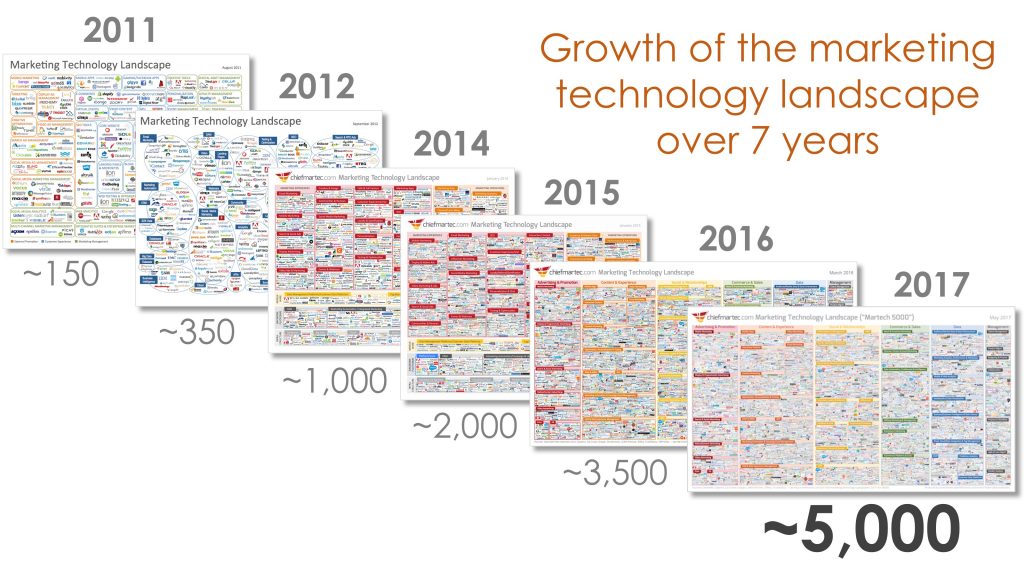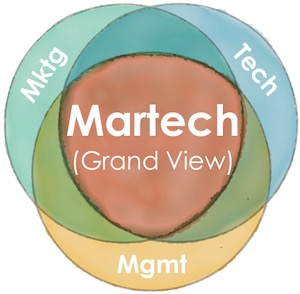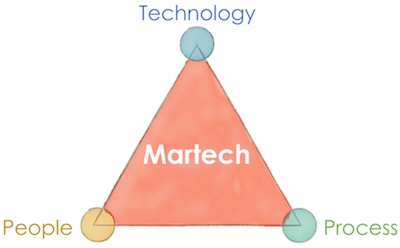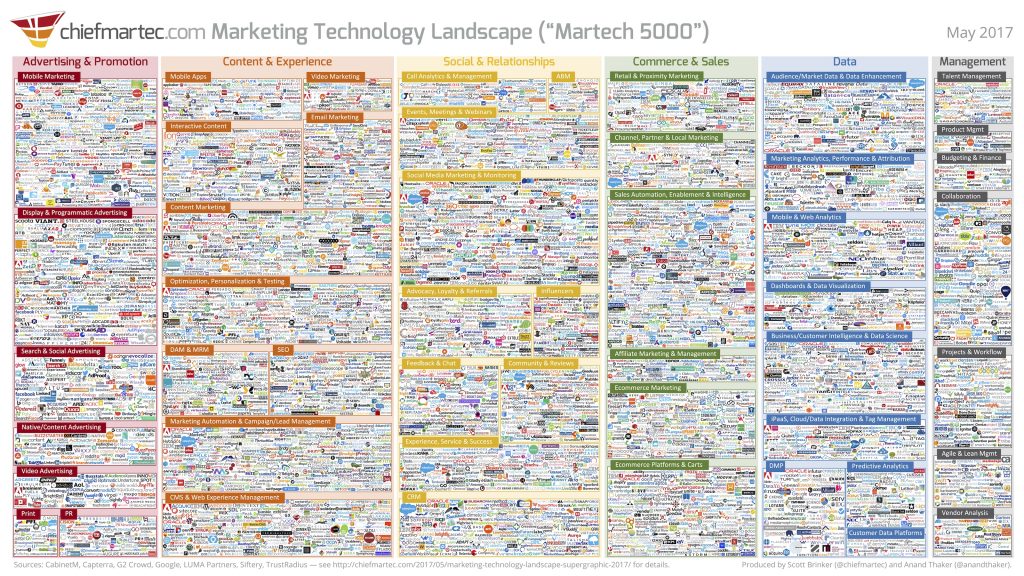Impossible to Keep Up With The Growth of Marketing Technology
If you’ve been following the Martech landscape you will have observed the exponential growth of vendors in the space over the past 7 years, from 150 odd vendor solutions in 2011 to a staggering 5,000+ vendor solutions in 2017 (just look at the image below). To say the landscape is beginning to get overcrowded would be an understatement. It is estimated that the average marketer uses 100 different pieces of software a month and they don’t even know about 90 of them!
Just within the last couple of years, marketing technology budgets have surpassed advertising budgets and the number of vendors has almost doubled! Given the speed at which the landscape is evolving, it’s no surprise that an increasing number of marketers are acknowledging that their companies aren’t using marketing technology as much as they ought to. In most cases, it’s not a matter of a lack of competence that’s fuelling the disconnect between innovation and adoption, rather it’s simply because it’s virtually impossible for any marketer or company to keep up with the rapid pace of change.
In the current state it’s imperative to weed through the clutter to discover, assess and adopt viable technological solutions that can add effective business value over both the short and long terms. Furthermore, selecting vendors that seamlessly and efficiently integrate within your tech stack, while simultaneously driving incremental value and cost savings has become a commonplace discussion in boardroom meetings. Although many marketers may feel inundated and overwhelmed by the challenge of adopting new marketing technologies, it is truly an exciting time to be in marketing, as it becomes the center of the customer experience. Scott Brinker, the Co-Founder and Chief Technology Officer at Ion Interactive, calls the current environment “the golden age of marketing”.

The Platformization of Marketing Technology
As new disruptions and innovations shake up the world of marketing, it is now impossible for any one vendor to be the one-stop shop for all your marketing needs. In fact, the $1 billion+ revenue heavyweights are also struggling to stay ahead and are relying on strategic acquisitions of smaller vertical specialists to fuel and enhance their product and service offerings. However, the majority of small and mid-sized providers acknowledge the complexity required to continuously build new products and have instead pivoted their strategies to embrace the evolving ecosystem and enable marketers to plug and play a variety of vertical solutions through their APIs. Doing so has made it much easier for marketers to implement and integrate new technologies into their stack and facilitate higher adoption rates.
According to the Walker Sands report, the gap between innovation and adoption appears to be shrinking as companies come up to speed with the evolving martech ecosystem. Adoption rates have been steadily increasing and can be attributed to a combination of factors including:
- Companies increasing their martech budgets
- Fewer roadblocks and less internal resistance
- Marketers recognizing the need for new tools
- Platformization of marketing technology
As the landscape continues to advance, and thousands of new vendors flood the marketplace with their more or less “novel” and “innovative” technological solutions, marketers are choosing to keep their options open and remain flexible when exploring new or alternative solutions. Instead of purchasing all-in-one turnkey solutions from the giant providers like Adobe and Oracle, market observers are noticing a growing trend of companies purchasing multiple SaaS based solutions from different vendors to build and customize their own martech stacks. This trend of building the best-of-breed architecture is quickly gaining momentum across all sizes of business.
Why Should All of This Matter to You?
With the advent of thousands of new technology providers, a lot more people are being involved in the decision making of which tools to implement and avoid. Executives all the way down to junior campaign managers are being looped in the process. In fact, according to the Walker Sands State of Marketing Technology 2017, the purchase decision making process of new technological solutions from vendors has become so democratized now that “7 out of 10 marketers (71%) reported to have led a purchase decision for at least one tool”. Also, it’s been estimated that over half of entry-level marketers have played a major role in a purchase decision since 2013! This is a dramatic shift from traditional marketing roles as marketers are expected to learn and manage new software, while simultaneously think and act like software developers as technology stacks increasingly get more complex.
If you’re a marketer, the changing landscape presents a multitude of unique opportunities. With the democratization of marketing technology, you will continue to become more and more empowered to decide which tools to purchase for fulfilling your responsibilities and will have greater flexibility in adding or subtracting new technologies from your stack! If you’re a higher-level executive, you’ll quickly see the growing need for your company to adopt a variety of new technologies as swiftly as possible. Given the nature of your business and the associated costs of inefficiencies it may be worthwhile exploring the possibility of bringing experts on board to help expedite the process of building and managing effective martech stacks in a holistic and integrated way. Once the capabilities are aligned, the next steps would be to prove thought leadership to your teams on how to effectively utilize the growing suite of tools at their disposal.

As martech continues to evolve, some companies have managed to identify best practices for navigating through this landscape . Given martech lives at the intersection of marketing, technology and management, one thing is for certain – to maximize on this unique opportunity the silos set up within marketing (i.e. search, social media, mobile, email, video, etc) need to be dismantled and instead give to agile marketing where the customer is the focal point. Doing this will help your business to evaluate emerging innovations while scaling the most important ones into your core.

References
N., & Professionals, M. I. (n.d.). Is Your Company Keeping Up With the Evolution of MarTech? Retrieved February 21, 2018, from https://www.insightsforprofessionals.com/blog/is-your-company-keeping-up-with-the-evolution-of-martech
Litsa, T. (2017, December 13). The state of Marketing Technology by Scott Brinker. Retrieved February 21, 2018, from https://www.clickz.com/state-marketing-technology-scott-brinker/202981/
Marketing Technology Landscape Supergraphic (2017): Martech 5000. (2017, May 11). Retrieved February 21, 2018, from https://chiefmartec.com/2017/05/marketing-techniology-landscape-supergraphic-2017/
The Evolving State of Marketing Technology. (n.d.). Retrieved February 21, 2018, from https://www.shopify.com/content/the-evolving-state-of-marketing-technology
W. (2017, October 12). The Evolution of Marketing Technology and What It Means for Marketers. Retrieved February 21, 2018, from https://vengreso.com/blog/evolution-marketing-technology






